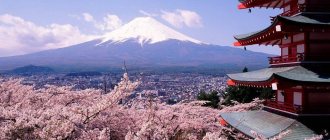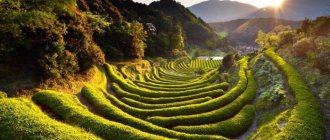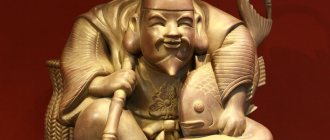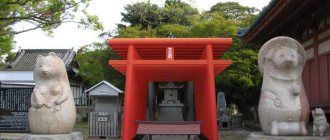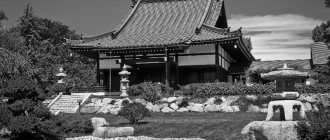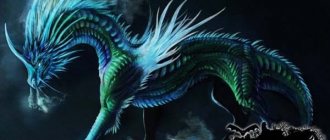We have heard and know a lot about the ancient Greek and Roman gods, about the Viking deities, but what do we know about the ancient Japanese gods? If we talk about the divine pantheon of the Japanese, it largely originates in the traditional mythology of Shintoism, the most ancient Japanese religion.
Japanese culture has influenced Buddhism and even Hinduism throughout history. The gods and goddesses of the Japanese were based on kami - mythical spirits and various mythical creatures. The Japanese described all this already in the 8th century, making a certain standardized template for the Shinto pantheon for almost all of Japan. Next you will get acquainted with some Japanese gods.
Original Japanese gods of the creation of the world
As in most folklore myths of different cultures about the creation of the world, Japan also had such creator gods. They are Izanagi and Izanami. This is a brother and sister duo. They brought order to the ocean of chaos under the sky. Izanagi and Izanami created the first continent. This was Onogoro Island. These gods were directed to this by even more ancient kami who lived in the sky. The divine brother and sister created the earth's firmament while standing on a ladder leading from heaven. They churned the ocean below them with a special precious spear until the island of Onogoro appeared. The brother and sister had deformed children.
One of them was the god Hiruko. The divine duo continued to create more and more islands. There were eight of them in total. They were inhabited by 800 spirits. When Izanami gave birth to Kagutsuchi, the god of fire, she could not bear the pain and died. After her death, she went to the underworld of Yomi. Her brother Izanagi went down there, but instead of his sister he saw a decomposing corpse. By this he angered the kami, who expelled him from Yomi. Returning to earth, Izanagi performed a cleansing ritual, which resulted in the appearance of a large number of other Japanese gods and goddesses.
Ancient Chinese mythology
One of the most ancient myths is called the myth of chaos. According to the ideas of the ancients, out of the void in which the images wandered, the cosmos and the two main gods appeared - Pangu and Nuiva. Pangu created the sky, earth, and elements passively, unconsciously. When he died, the parasites in his body became human.
The goddess Nuwa was a woman whose lower body was snake-like. She created all things in the world. When, according to legend, there was a war of the gods, and the sky stopped holding, she herself repaired the sky. She used the legs of the mythical turtle Ao to prop up the sky.
Goddess Nuiva
The oldest hero of Chinese mythology is Fuxi, who is represented in the form of a human bird. He taught people hunting, fishing and frying meat, and invented fishing nets. His image embodied the idea of ancient tribes about the totem animal - the swallow.
According to legend, Fusi and Nüwa got married and restored the human race after the flood.
God of luck and fishermen
Hiruko was the first child of the gods who created the earth. But he was born very ugly, since Izanagi and Izanami violated the marriage ritual. Hiruko is often called Yobisu. It brings good luck to fishermen. When Hiruko was born, he had no bones. When he was three years old, his mother threw him into the ocean, but the child survived. Ebisu Saburo helped him, so Hiruko began to call himself Yobisu. This god has always patronized children and fishermen.
It also brings good luck. Yobisu is also called the laughing god, he never loses heart. On his head he wears a pointed kazaori eboshi hat. Yobisu is the god of jellyfish because he has no bones.
Other important creatures
The mythology of Japan is the subject of much discussion, and the number of characters can number in the hundreds. Let's talk about other, most popular heroes of myths and legends.
- Tanuki are funny badgers or raccoon dogs that can bring happiness. They make fun of people, love to drink sake, and their scrotum can become so incredibly large that sometimes the tanuki himself takes refuge under it. It is believed that the larger it is, the greater happiness there will be.
Japanese Tanuki Raccoon
- Kitsune is a one-, five-, or nine-tailed fox with silver fur that can turn into a human and even start families with people. They can be either attached to people and kind towards them, or evil.
Werefox Kitsune
- Kirin is a Japanese divine dragon. Unlike his Chinese brother Qi-Lin, he has not 5 toes on each foot, but 3.
Dragon Kirin
- God Yato, whose real name is Yaboku, is a relatively modern character, best known from the fantasy manga work The Homeless God. This is a deity of death who was almost forgotten and who has no sanctuary.
"Homeless God" Yaboku
- Tengu is a humanoid creature with a red face, an angry expression and a large, long nose. Its body is enormous in size and sometimes has wings. Tengu is very strong and skilled in battle.
Tengu
- Ayakashi is a snake that lives in ponds and seas and reaches a length of 2 kilometers.
Sea Serpent Ayakashi
- Bake-neko - a cat -
a werewolf, a demon, capable of possessing people. They are distinguished by several tails. Therefore, many kittens used to have their tails docked so that they would not split in two, and after the death of the owner, the cat would be closed so that the soul would not move into them.
Bake-neko cat
God of destructive fire
Kagutsuchi, the god of fire, was also the child of the divine couple. He burned his own mother with his fiery essence. His father Izanagi became angry. He could not bear the death of his wife and wife, so he cut off the head of the son who killed his mother. Blood flooded the earth and gave birth to even more spirits, among whom were the thunder gods, mountain gods and the dragon god. The Japanese considered Kagutsuchi the progenitor of many powerful gods who created iron and weapons. The god of fire was the destroyer of buildings, especially wooden ones. There are many religious rituals associated with it that pacify it.
Fire in Shinto rituals
The Japanese have long had a great fear of fire and the destruction it can cause, not least because Japanese buildings were traditionally made of highly flammable wood and paper walls with wooden slates or grass roofs. Fires destroyed almost all the major ancient buildings and temples in Japan's ancient cities over the centuries, and during the Edo period (1603-1868 CE), fires in the capital of Edo (modern Tokyo) were so frequent that they became known as "flowers" Edo."
It is not surprising that ceremonies to appease and scare away Kagutsuchi were a common feature of Shinto ritual. In such rituals and prayers, Kagutsuchi is usually referred to as Homusubi, which translates to "he who kindles the fire." The ancient Japanese held a ceremony twice a year, sponsored by the imperial court, whose vast palace complexes were often victims of fires. The ceremony was designed to please the god and ensure that he would contain his terrible flames for another six months. The destructive fire of Kagutsuchi is contrasted with the purifying fire of Shinto rituals known as kiri-bi, which was traditionally produced by rubbing two pieces of hinoki wood, a type of cypress.
Kagutsuchi is sometimes equated to Atago Gongen, another fire kami. Strictly speaking, Atago Gongen is a more positive figure in Japanese mythology and acts as a protector or guardian of fire.
Goddess of the Rising Sun
The Japanese call their goddess of the rising sun Amaterasu, or shining from heaven.
She is revered as the ruler of the kami kingdom, the High Heavenly Plain of Takama no Hara. She maintained the greatness, order and purity of the rising sun. Amaterasu is considered the ancestor of the imperial family.
She was born from Izanagi's left eye when he was cleansing himself of spirits.
In another myth, Amaterasu locked herself in a cave when a quarrel occurred between her and the storm god Susanoo.
Then the earth was covered in darkness. Only thanks to the jokes and persuasion of the other gods, Amaterasu left the cave, bringing with her sunlight. This goddess has always played an important role in Japan.
Many noble families claimed that their family descended from her.
"The Legend of Narayama"
Like the example described above, this title also belongs to the 1983 film. The director and screenwriter Shohei Imamura got to work, taking the stories of Shichiro Fukazawa as the basis for the plot.
Genre: drama.
Plot. Famine reigns in a small primitive village - 19th century. In the village, only the eldest sons are allowed to create families, while the younger ones are used as workers. Girls are sold or exchanged for things, such as salt. Babies are sometimes killed, and families who steal someone else's crops are buried alive.
The meaning of the Narayama legend in Japan is that the village has a truly creepy custom. Elderly people over 70 years of age should no longer receive food as they are considered “extra mouths to feed.” Therefore, the eldest son is obliged to take his father or mother on his shoulders and carry him to Mount Narayama, where the ancestor will remain to die of thirst and hunger.
Moon God
Tsukuyomi, the Japanese moon god, is male. Tsuku means "month" and yomi means "reading". He was born from the right eye of Izanagi and, accordingly, he is the brother of Amaterasu. Tsukuyomi married his sister. Therefore, they united in one heaven. One day, Tsukuyome killed the goddess of food, Uke Mochi. After this terrible act, the relationship between Amaterasu and Tsukuyomi went wrong, and they began to appear in the sky at different times, never meeting each other again. This is how day and night appeared.
Kaori
The girl, having entered high school, wanted to celebrate this event by piercing her ears. To save money, she decided to do it herself and at home. After a few days, her ear began to itch. Looking in the mirror, Kaori discovered a white thread in the earring and immediately realized that the itching was precisely because of it. When she pulled out the thread without a second thought, the light in front of her eyes immediately went out. It turned out that the cause of the high school student’s illness was not just a thread, but the optic nerve, the rupture of which led to blindness.
After such a tragedy, the girl began to persecute others. If the answer to her question “Do you have your ears pierced?” was yes, then she would bite them off for the unfortunate victim.
God of the seas and storms
Susanoo, god of seas and storms, another brother of Amaterasu. It came out of Izanagi's nose. His appearance was very disheveled, and his character was quarrelsome. Susanoo was constantly plagued by mood swings. This manifested itself in storms and bad weather. He was both benevolent and unkind. In Japan, located on the islands, there are many shrines dedicated to this god. Susanoo often fought and defeated the dragon. He cut off 10 heads of the monster and drank its blood. At the same time, he was also a negative god. He destroyed his sister's rice fields and even killed her servants.
Religion of Japan
Despite many centuries of isolation from European and other countries, Nippon (as the Japanese call their homeland) surprises with the diversity of religious teachings. Among them, the main place is occupied by Shintoism, which is professed by more than 80% of the population. In second place in importance is Buddhism, which came to Japan from neighboring China. There are also representatives of Confucianism, Christianity, Zen Buddhism, and Islam in the country.
A feature of the Nippon religion is syncretism, when the overwhelming number of residents profess several religions at once. This is considered normal practice and is an excellent example of the Japanese people's religious tolerance.
Weather Gods
Raijin and Fujin are gods of the natural elements. Raijin controlled lightning and brought down storms on mortals. He beat his drums with a giant hammer. Raijin is depicted with three fingers, symbolizing the past, present and future. Fujin is the master of the winds, which he carries in a bag over his shoulders. Fujin is the savior of Japan from the Mongol invasion, sending the divine kamikaze wind to them. You can often hear about him in myths about samurai. Fujin comes from the god of war, Hachiman.
Demons
Chinese mythology is very different from the myths of other countries, but there are demons here too. The main demon of Chinese mythology is Zhong Kui. His image was used for magical rituals. The lord of the underworld is Yanwan, who judged the dead and determined punishment. The lord of all demons and monsters was Zhang Tianshi. In Chinese mythology, the king of snakes was the monstrous Man. Even though it is a snake, it is depicted as a dragon with 4 fingers.
Zhong Kui
Demons and ghosts are animals that return to take revenge for cruel treatment during life - Yaoguai. There are stories about wild cats turning into werewolves and feeding on human energy. The number of minor monsters is huge, so the list of everything can be endless.
God of War and Archery
Hachiman, the god of war, is between Buddhism and Shintoism. It evolved and became venerated in many Buddhist shrines. This happened at the end of the 9th century. As a Buddhist deity, Hachiman is revered as a bodhisattva. He is the guardian of shrines in Japan. This god is associated with war and culture. His avatars resided in Empress Jingu, who was at war with Korea, and her son, Emperor Ojin, around the 3rd century. He was the patron of the Minamoto clan in the 11th century. The Japanese also say about Hachiman that it was he who sent the divine kamikaze wind to the Mongolian fleet.
Origins
The mythological Far Eastern system is known from the “Records of Ancient Acts” (“Kojiki”), compiled by order of the ruling Yamato clan, dated 712, and the “Annals of Japan”, which came from 720. The most significant ancient collection, the Kojiki, includes 3 scrolls, of which the first is dedicated to oral traditions passed down from generation to generation (Takamagahara), and the other two are dedicated to the actions of divine children. These events reflect the history of the Land of the Rising Sun. The second scroll is dedicated to the events of Izumo (the prototype of the region is Shimane), the third tells about Tsukushi (Kyushu), where the god Ninigi ruled. The Kojiki is unique - it is the main Shinto holy book of the three main ones, as well as a key ancient Japanese literary monument.
Many ancient myths are given in the collection "Man'yeshu" compiled in the 8th century, in the "Engi Shiki", which lists traditional songs performed at court in the 10th century.
All the sacred knowledge of the inhabitants of the Land of the Rising Sun is unusual, unique, and unlike that common in other lands. They represent people as divine descendants, include the foundation of Shintoism and reflect the mentality, spirituality, and psychology of the Japanese that have developed since ancient times.
In mythology, people are descendants of gods
Influence of religion
Heroes, gods, and creatures known from Japanese mythology reflect the main ancient religion of the population of the archipelago - Shintoism. The essence of the direction is the veneration of many sacred kami. The teaching is closely related to Buddhism, the way of Tao and the ideas of Confucius. The peculiarity of Shintoism is the absence of strict dogmas and written canons. The way of Shinto includes the philosophy of folk beliefs and legends reflected in the Kojiki and Nihon Seki. It was formed under the influence of the provisions of “Fudoki” (a work on folk customs and Japanese lands), the decrees of semme, mentioned in a number of chronicles, and the codes that governed the ceremonies.
Shintoism as a religious reflection of the history of the Land of the Rising Sun is a mythological justification for the power of the emperor, who was revered as a divine descendant, the heir of Amaterasu. Ancient myths tell about the struggle of Yamato traditions with local foundations and codes, which ended in the unconditional victory of the rules of the ruling dynasty.
From encyclopedias of myths and religious tales of ancient Japan, it is known that it is Shintoism, Buddhism and folk beliefs that are the source of the polymorphism that characterizes the country today. The structure of society and the family is subordinated to Confucian ideas, the path of Tao determines the connection between man and nature, Buddhism talks about the role of the individual in the state, and Shintoism, formed on the basis of ancient myths, determines the place of the individual in the world.
Since the 13th century, the Land of the Rising Sun has been the site of the development of local cults of ancestor gods. At the same time, Shintoism is being revised without connection with Buddhism, and the “Fivefold Scripture of the Way of the Gods” is being distributed. The ancient teaching is presented as superior to that created by ordinary people (for example, Confucius).
The Way of Shinto is based on ancient myths
